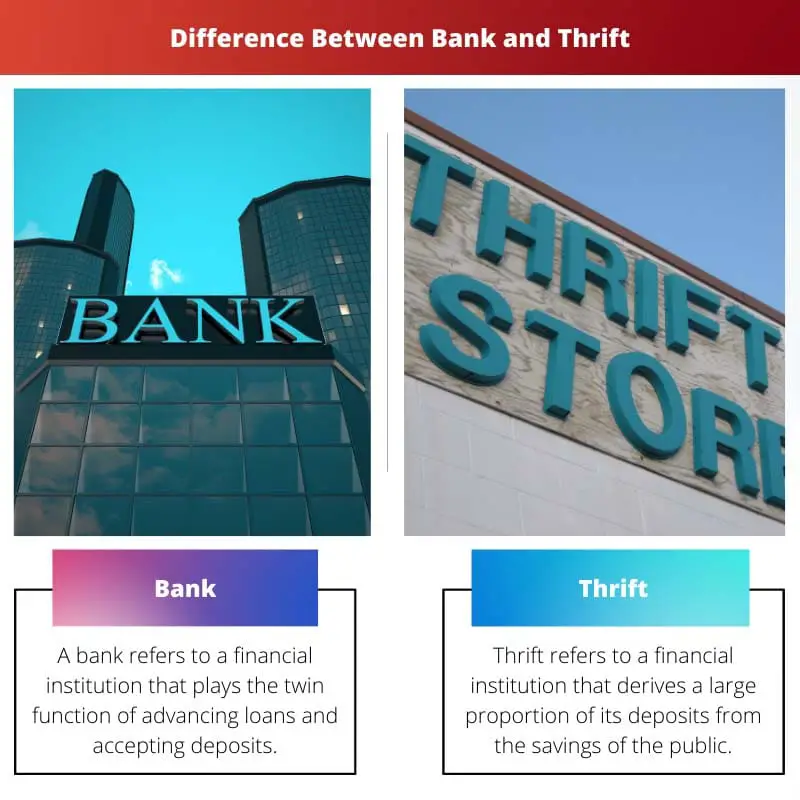Financial institutions play a crucial role in the economic stability of an economy. A bank and thrift are two financial institutions that play an important role in satisfying the needs of consumers as well as business enterprises.
However, there are considerable differences between a bank and a thrift.
Key Takeaways
- Banks primarily provide loans and financial services to individuals and businesses, while thrifts specialize in residential mortgages.
- Banks offer a wider range of financial products, while thrifts concentrate on savings accounts and loans.
- The OCC regulates banks, while the OTS regulates thrifts.
Bank vs Thrift
The difference between bank and thrift is that Banks serve the needs of both businesses and consumers. On the other hand, thrifts provide services to only consumers and not businesses. The federal or state government issues a charter in the case of banks. In contrast, the financial regulatory division of the state government or the federal office of thrift supervision issues a charter in the case of thrift.

A bank refers to a financial institution that plays the twin function of advancing loans and accepting deposits. There are two types of banks in almost every country: central banks and commercial banks.
Risks faced by banks include liquidity crunch, market risk, credit risk, liquidity risk, macroeconomic risk, operational risk, and reputational risk.
Thrift refers to a financial institution that derives a large proportion of its deposits from the savings of the public. There are multi-facet cooperative banking models offered by thrift.
The portfolio of thrift banks needs to com[a rise of at least 65% of consumer loans. Thrift banks existed in the United Kingdom in the early 18th century.
Comparison Table
| Parameters of Comparison | Bank | Thrift |
|---|---|---|
| Target Groups | Banks serve the needs of both businesses and consumers. | Thrifts provide services to only consumers and not businesses. |
| Services | Banks offer comparatively more services and facilities as compared to thrift banks. | Thrift banks offer only a limited range of services and accounts to consumers. |
| Charter | The federal or the state government issues a charter in the case of banks. | The financial regulatory division of state government or the federal office of thrift supervision issues a charter in the case of thrift. |
| Liquidity | Banks possess low liquidity to provide consumers with home mortgage loans. | Thrift banks possess high liquidity to provide consumers with home mortgage loans. |
| Regulation | Banks are less regulated as compared to thrifts. | Thrifts experience more regulation in comparison to banks. |
What is a Bank?
A bank refers to a financial institution that plays the twin function of advancing loans and accepting deposits. Banks play an indispensable role in the economic stability and growth of a country.
In addition, banks advance loans either directly or indirectly through capital markets. Banks are regulated by higher authorities.
There are two types of banks in almost every country: central banks and commercial banks. The central bank of India is called the Reserve Bank of India.
Other central banks include the Reserve Bank of England and the federal reserve system. Several commercial banks include the State Bank of India, Punjab National Bank, and HDFC Bank.
Some methods include transaction fees, interest, and financial advice. However, the most significant method of revenue generation is the interest charged on the loans or deposits kept by the public in banks.
Banks provide several retail provisions. Some of these include credit cards, debit cards, mortgages, personal loans, demand deposits, ATMs, NEFT, and RTGs.
Risks faced by banks include liquidity crunch, market risk, credit risk, liquidity risk, macroeconomic risk, operational risk, and reputational risk. To conclude, banks offer varying provisions to consumers.

What is Thrift?
Thrift refers to a financial institution that derives a large proportion of its deposits from the savings of the public.
There are multi-facet cooperative banking models offered by thrift. Some of the examples include savings and loan associations, mutual savings banks, and credit unions. Thrifts offer wider savings facilities but limited lending services.
Thrift banks provide several facilities. The services include traditional savings accounts, checking accounts, home loan origination, personal and car loans, and credit cards for customers.
In addition, it also provides home mortgages for the general public. Thrift banks came into existence in the early 18th century in the United Kingdom.
A thrift bank is identical to corporate firms wherein the shareholders have primary ownership. The size of thrift banks is relatively small. The main objective of thrift banks is to provide a wide plethora of services to the consumers in the market.
Over the years, thrift banks have undergone several structural changes bridging the gap between conventional banks and financial institutions.
Thrift banks are allowed to give 20% of their assets in the form of commercial loans to potential consumers. The portfolio of thrift banks needs a rise of at least 65% in consumer loans.
In addition, thrift banks are provided with low-cost funding. Thrift banks also impart loans at relatively low rates of interest.
Main Differences Between Bank and Thrift
- Banks serve the needs of both businesses and consumers. On the other hand, thrifts provide services to only consumers and not businesses.
- The federal or state government issues a charter in the case of banks. In contrast, the financial regulatory division of the state government or the federal office of thrift supervision issues a charter in the case of thrift.
- Banks offer comparatively more services and facilities as compared to thrift banks. On the other hand, thrift banks offer only a limited range of services and accounts to consumers.
- Banks possess low liquidity to provide consumers with home mortgage loans as compared to thrifts.
- Banks are less regulated as compared to thrifts.





